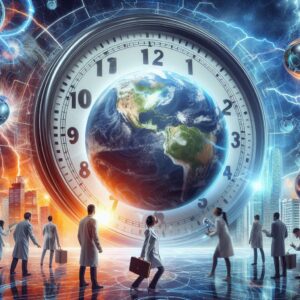 So, let’s talk about this Doomsday Clock. No, it’s not a creepy grandfather clock in a haunted house. This clock has been ticking for 77 years, and it’s not counting down to your birthday party.
So, let’s talk about this Doomsday Clock. No, it’s not a creepy grandfather clock in a haunted house. This clock has been ticking for 77 years, and it’s not counting down to your birthday party.
Instead, it’s trying to tell us just how close we are to turning our planet into a post-apocalyptic wasteland. You know, the kind of place where tumbleweeds roll through the ruins of civilization.
90 Seconds to Midnight: Is This the Final Countdown?
This year, the folks at the Bulletin of the Atomic Scientists—yes, the same smart people who made the atomic bomb—set the clock at 90 seconds to midnight. That’s the closest it’s ever been, and if you’re thinking that sounds bad, you’re right.
Last year, it was also at 90 seconds, thanks to Russia’s invasion of Ukraine and the not-so-comforting thought of nuclear weapons getting dusted off.
Just a few years ago, from 2020 to 2022, we were chilling (well, sort of) at 100 seconds to midnight. But things aren’t exactly getting better. The clock isn’t some precise tool that measures how much time we’ve got left, but more of a flashing neon sign saying, “Hey, maybe we should talk about this?”
What’s Keeping Us So Close to the Edge?
You’d think with everything going on, we’d be moving that hand back a bit, but nope. The decision to keep the clock at 90 seconds this year has a lot to do with the usual suspects: the ongoing mess in Ukraine, the Israel-Gaza conflict, and the ever-looming threat of a nuclear arms race. Oh, and don’t forget climate change—the gift that keeps on giving.
We’ve just lived through the hottest year on record, and Mother Nature isn’t pulling any punches with floods, fires, and other disasters that seem to be auditioning for the next big disaster movie.
Plus, with all the buzz about artificial intelligence, there’s a whole new set of questions about whether these robots are going to help us out or just join the list of things trying to end the world as we know it.
Wait, What Exactly Is This Clock?
For those of you wondering, “Who even came up with this idea?”—let me enlighten you. The Doomsday Clock was created by scientists who were part of the Manhattan Project (yep, the atomic bomb thing) way back in 1947. Originally, it was just about nuclear threats, but in 2007, they decided to add climate change into the mix, because why not make things even more complicated?
Over the past 77 years, the time on the clock has changed depending on how close these experts think we are to, well, the end. Sometimes they move the hand forward, sometimes back, and sometimes they just leave it where it is, like they did this year.
It’s set by a group of super-smart people who know their stuff, including nine Nobel laureates. So yeah, this isn’t just a random guess.
But Is This Clock Really Helpful or Just a Gimmick?
Now, some folks out there might say, “Isn’t this clock just a little melodramatic?” And sure, it’s not perfect. It mixes together all kinds of risks—nuclear war, climate disaster, AI taking over—and slaps them onto one timeline.
But it’s still a pretty powerful reminder that we’re living on the edge here. It’s like having a smoke alarm that doesn’t just beep when there’s a fire but also when your house is about to collapse and your fridge is running out of ice cream.
What Happens if the Clock Hits Midnight?
Here’s the thing: the clock has never hit midnight, and we’re all hoping it never does. Midnight means we’ve officially messed things up beyond repair—like nuclear war or catastrophic climate change. And if that happens, we probably won’t even notice the clock hitting midnight because, well, we’ll be too busy dealing with the fallout.
So, How Accurate Is This Thing Anyway?
Let’s be clear: the Doomsday Clock isn’t meant to be an exact science. It’s more about starting conversations and getting people to pay attention to some pretty heavy topics, like nuclear disarmament and climate change. If it gets people talking, then it’s doing its job.
And it does seem to work. Remember the COP26 climate talks in 2021? Even former UK Prime Minister Boris Johnson couldn’t resist mentioning the Doomsday Clock when talking about climate change. So yeah, people are listening.
Can We Turn Back the Clock?
Here’s the good news: the clock’s hands can move backward. It’s happened before, like in 1991 when the U.S. and Soviet Union signed a treaty to reduce their nuclear arsenals. That moved the clock to 17 minutes before midnight—practically the Stone Age in Doomsday Clock time. In 2016, the Iran nuclear deal and the Paris climate accord pushed it back to three minutes before midnight. So, it’s possible.
But it’s not going to be easy. Turning back time on the clock means serious work, not just from governments but from all of us. Every little bit counts, whether it’s cutting down on driving, using less energy, or just talking about these issues with friends and family. After all, we’re the ones who got ourselves into this mess, so it’s up to us to clean it up.
And there you go—our grim countdown to oblivion, served with a side of wit. The Doomsday Clock isn’t just about doom and gloom; it’s a call to action. So, let’s hit the snooze button on this thing before it’s too late.




